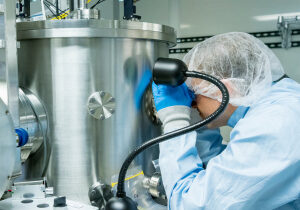MSU Grant Creates ‘One-Stop Shop’ for Photonics Development in Montana
$1.1M federal grant eliminates testing bottleneck that forced Montana companies to seek services elsewhere
By Staff Writer
Oct 27, 2025
BOZEMAN — Montana State University received a $1.1 million federal grant to eliminate a critical bottleneck that has been forcing the state’s growing photonics companies to seek testing services elsewhere, potentially slowing the momentum of Montana’s emerging technology sector.
The grant from the U.S. Economic Development Administration will allow MSU’s Montana Microfabrication Facility to purchase equipment for assembling and testing photonic integrated circuits, or PICs—specialized computer chips that manipulate light instead of electrons.
“We currently have the tools and expertise to prototype specialized PICs using semiconductor manufacturing equipment, but we have no capability in-house to verify that they are producing the desired results,” said Andrew Lingley, manager of the Montana Microfabrication Facility. “Testing PICs and assembling them into packages at MSU will allow our students, researchers and industrial clients to complete the whole prototyping cycle right here with rapid iterations and design improvements.”
The infrastructure gap has practical implications for companies like Eshylon Scientific, the California semiconductor firm that relocated its entire operation to Montana earlier this year specifically to access MSU’s quantum and photonics capabilities. Without in-house testing, such companies face delays and higher costs when developing new products.
PICs are essential components in technologies ranging from video conferencing and AI data centers to precision agriculture and autonomous vehicles. The global photonics market is projected to reach $1.3 trillion by 2030, according to industry analysts.
“PICs are similar to computer chips, but they manipulate and make use of light instead of electrons,” Lingley explained. “PICs already enable technologies like video conferencing and AI data centers, and they are increasingly being developed for sensing applications like lidar and precision agriculture.”
The 30-month grant builds on Montana’s selection in 2023 as one of 31 Regional Technology and Innovation Hubs by the Economic Development Administration. That designation led to $41 million in federal funding for the Headwaters Regional Technology and Innovation Hub, which aims to establish Montana as a leader in photonics and quantum technologies.
The Montana Photonics and Quantum Alliance, a nonprofit established in 2013, received part of the $41 million to create an Integrated Photonics Ecosystem supporting the Bozeman region as a hub for optics, photonics and quantum technology.
Over the next 30 months, MSU’s facility will use the new funding to purchase PIC assembly and testing equipment^1, hire a dedicated photonics equipment engineer and support undergraduate employment positions. The upgrades will particularly benefit researchers from MSU’s Optical Technology Center, established in 1992 as a multidisciplinary research center focused on optics and photonics.
“Bozeman will continue to attract photonics businesses, and MSU will continue to spin out new photonics companies,” Lingley said. “This is especially true because we produce well-trained students who have extensive hands-on experience.”
The workforce development aspect addresses a key competitive advantage Montana has developed. Students gain direct experience with the same equipment used by industry, creating a pipeline of skilled workers for companies establishing operations in the state.
Alison Harmon, MSU’s vice president for research and economic development, noted that MSU faculty are leaders in smart photonic sensor systems, the core technology for the Headwaters hub.
“The MMF is an MSU core facility with very strong industry ties in addition to providing students with valuable learning experiences and training,” Harmon said. “The IPE exemplifies MSU’s commitment to economic development and will allow us to continue to build testing capabilities that speed up the process of research translation for MSU researchers and Montana businesses.”
The Montana Microfabrication Facility operates as a shared cleanroom environment in MSU’s Barnard and Cobleigh halls, providing access to advanced nanofabrication tools and technical expertise for students, faculty researchers and industry partners.
With the new testing capabilities, Montana positions itself to offer companies the complete photonics development cycle—from initial research through prototype testing to final product development—all within the state’s borders.
Categories: Education, Government, Technology
Don’t miss the week’s top Montana stories
Join readers across Montana who rely on WMN for independent reporting.
Unsubscribe anytime. Want to support WMN? Upgrade for $4/month →





